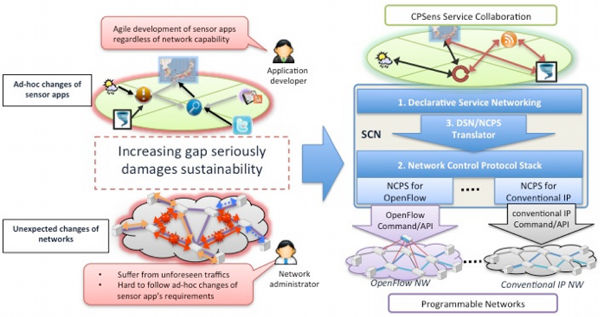Information Services Platform Lab. > Topics
Information Services Platform Lab. > Research > Service-Controlled Networking
Information Services Platform Lab. > Member
Information Services Platform Lab. > Publications
Information Services Platform Lab. > Resources
Service-Controlled Networking
To efficiently implement an applications in which information services work in conjunction with one another, we are researching and developing Service-Controlled Networking (SCN) middleware that dynamically controls network resources in response to demand of service collaborations. For example, SCN middleware is effective in responding to unexpected situations such as disaster cases by establishing an alternative communication path to avoid congestion and by discovering alternative information services. SCN is implemented as middleware located between programmable network infrastructures (e.g., OpenFlow, virtualized node infrastructure) and information service platform (e.g., services computing and clouds). Programmable networks provide commands and API’s to operate networks from software. SCN middleware leverages this functionality to automatically adjust network configurations to satisfy application-specific service collaboration requests.
SCN middleware consists of the following components.
- Declarative Service Networking (DSN) for describing declarative rules specifying service collaboration requests.
- Network Control Protocol Stack (NCPS) for executing commands that controls programmable networks.
- Mechanism that interprets DSN descriptions and converts them into a sequence of NCPS commands.

The purpose of SCN is to enable application developers to easily implement service composition. For instance, users can create a virtual sensor that collects and analyzes various sensor data related to natural and social phenomena only by specifying the services to be used (e.g. weather service, thermometer and hygrometer, and notification service) and the constraints (e.g. transferring 1,000 messages per minute). Complying with this requirement, SCN automatically generate both of logical and physical networks to satisfy the requirements.






